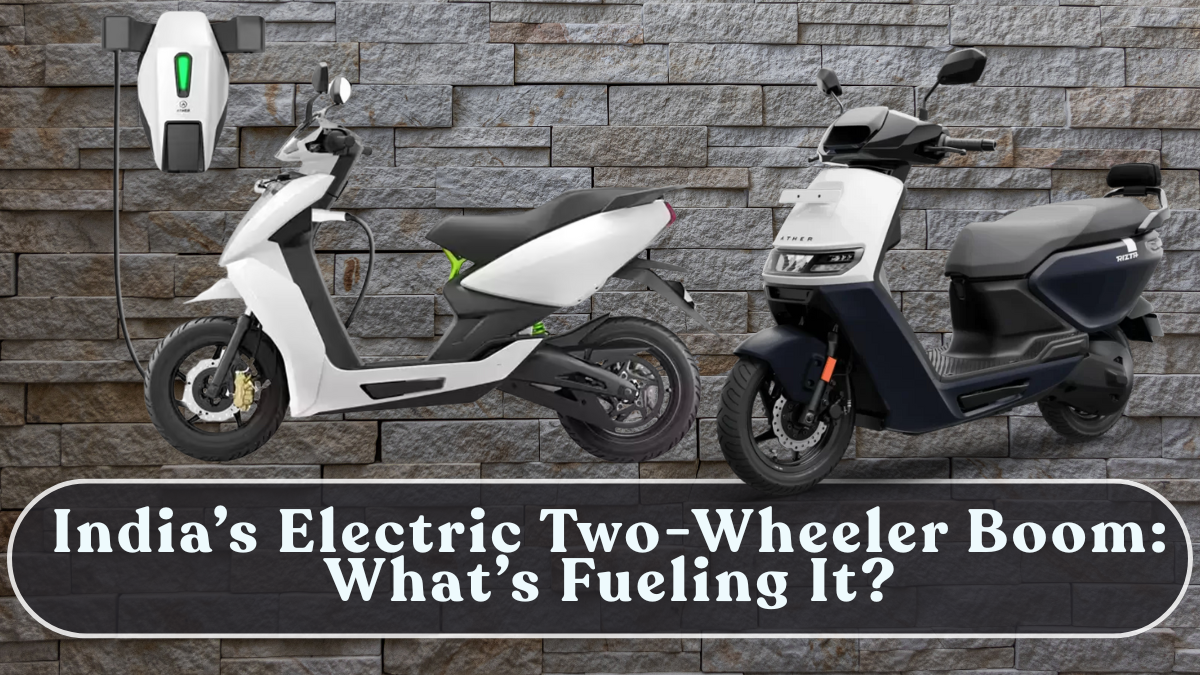India’s electric two-wheeler boom is rewriting the rules of mobility. What started as a niche alternative to petrol scooters has now become a full-fledged revolution. With growing fuel prices, stricter emission norms, and improved EV technology, millions of Indians are shifting to electric scooters and bikes. 2025 marks a major turning point — sales are projected to surpass two million units, driven by government incentives and rising consumer confidence.

Why India Is Moving Toward Electric Mobility
The shift toward EVs isn’t just a trend; it’s a necessity. India’s dependency on oil imports and urban air pollution forced policymakers and automakers to look for sustainable solutions. The FAME-II scheme (Faster Adoption and Manufacturing of Hybrid & Electric Vehicles), launched by the government, provides subsidies to buyers and manufacturers.
-
Petrol prices crossing ₹100/litre have made daily commuting expensive.
-
EVs offer running costs as low as ₹0.25 per km, compared to ₹2–₹3 per km for petrol bikes.
-
Rising awareness about climate change and clean energy adoption has made EVs socially appealing.
The Leading Players in India’s E-Scooter Market
The competitive landscape has intensified as both startups and established companies rush to capture market share.
| Brand | Popular Models | Price Range (₹) | Key Highlight |
|---|---|---|---|
| Ola Electric | S1 Pro, S1 Air | 1.1L–1.5L | Fast charging, app-based control |
| Ather Energy | 450S, 450X | 1.2L–1.6L | Premium design, smart dashboard |
| TVS | iQube | 1.1L–1.4L | Strong build, wide dealership |
| Hero MotoCorp | Vida V1 | 1.25L–1.45L | Swappable batteries |
| Bajaj | Chetak | 1.3L–1.6L | Retro design, solid range |
These brands are constantly improving battery efficiency, charging infrastructure, and digital features, such as GPS, app connectivity, and ride analytics.
Government Push and Policy Support
Government initiatives have been a key driver behind India’s e-scooter growth.
-
FAME-II subsidy: Up to ₹10,000 per kWh of battery capacity.
-
GST reduction: EVs taxed at only 5% vs. 28% on petrol bikes.
-
State incentives: Maharashtra, Gujarat, and Delhi offer direct rebates of ₹10,000–₹20,000 per vehicle.
-
Charging infrastructure: The government targets one public charger every 3 km in urban areas by 2026.
These initiatives make electric two-wheelers not only affordable but also practical for daily commuting.
Technological Advancements Driving the Boom
Technology is the backbone of this transformation. Battery costs have dropped by nearly 80% since 2013, enabling automakers to offer longer ranges at lower prices.
Recent innovations include:
-
Lithium-ion battery packs with over 100 km range.
-
Swappable batteries introduced by Hero Vida and Gogoro.
-
Smart BMS (Battery Management Systems) to prevent overheating.
-
Regenerative braking that increases efficiency by 10–15%.
EV manufacturers are also integrating AI-based diagnostics, smart navigation, and IoT connectivity for real-time performance tracking.
Challenges Still Facing the Industry
Despite rapid adoption, some barriers remain.
-
Charging availability: Many small towns still lack proper public charging points.
-
Battery disposal and recycling: India needs a formal recycling chain for used batteries.
-
High upfront cost: Even after subsidies, premium models remain costlier than petrol variants.
-
Consumer perception: Some riders still worry about range and long-term reliability.
Manufacturers are addressing these issues through local battery production and extended warranty programs.
Economic and Environmental Impact
The growth of electric two-wheelers has also created a ripple effect across the economy.
-
Thousands of local EV startups and component manufacturers have emerged.
-
Job creation in battery manufacturing and charging network installation is on the rise.
-
A 10% EV adoption rate can cut India’s oil import bill by over $1.2 billion annually.
-
Carbon emissions from the two-wheeler sector are expected to drop by 35% by 2030.
This shift not only benefits consumers but also strengthens India’s position in the global EV supply chain.
Conclusion
The electric two-wheeler boom in India is more than a mobility upgrade — it’s a national movement towards sustainability and independence from fossil fuels. As technology matures and infrastructure improves, electric scooters will soon become the default choice for urban commuters. The next five years will likely determine which brands dominate, but one thing is certain — India’s EV future is already here, and it’s two-wheeled.
FAQs
What is driving India’s electric two-wheeler boom?
Rising fuel prices, government subsidies, and improved battery technology are the main drivers.
Which are the top EV scooter brands in India?
Ola Electric, Ather Energy, TVS, Hero Vida, and Bajaj Chetak lead the market.
How much does it cost to charge an electric scooter?
Roughly ₹15–₹25 per full charge, giving around 100 km of range.
What government subsidies are available?
Under FAME-II, buyers can get up to ₹20,000–₹30,000 in subsidies depending on battery capacity.
Is it worth buying an EV scooter in 2025?
Yes. With better range, lower running costs, and expanding infrastructure, EVs are now a smart and future-ready choice.
